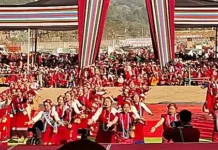Monday Musing
[Amar Sangno]
They say that to develop any state, an effective and dedicated bureaucracy is the key, along with strong political will. Apparently, these key elements are missing in Arunachal Pradesh right from the time it attained statehood in 1987.
The Indian Frontier Administrative Service (IFAS) had been created to manage frontier territories like the North East Frontier Agency, but it was later merged with the Indian Administrative Service (IAS) in 1968. Since then, Arunachal Pradesh has been clubbed with the Arunachal, Goa, Mizoram and Union Territories (AGMUT) cadre.
As per the latest allocation, Arunachal Pradesh has 42 total sanctioned officers in the AGMUT cadre. Chief Minister Pema Khandu argues that shorter terms and frequent transfer of officers have paralyzed the state’s development as several projects and policies had to be abandoned halfway because of the transfer of the officers who had initiated those projects. In fact, Pema demanded a separate cadre, through a resolution in the legislative assembly in October 2017, saying a separate cadre for the state would establish a team of dedicated officers who would ensure continuity in administration and governance.
“Central schemes could not be implemented and executed properly as officers come to the state for a short period and are not able to understand the tribal culture and sentiments,” the CM argued.
Arunachal Pradesh has long felt the need for a separate cadre. Parliamentarian Ninong Ering also advocated the same through a private resolution in the parliament. Ering argued that “the demand for a separate cadre has arisen due to the lack of a dedicated bureaucracy in the state, which has prevented developmental initiatives from percolating down to the grassroots level while abating continuity in administration and inducing a lack of passionate officers to serve the state.”
The popular argument for having a separate cadre is that the central government officials under the AGMUT cadre are there for a short period and therefore do not have an ‘institutional memory’ to be able to concentrate on the exact developmental and administrative needs of the state.
The shorter tenure of the officers from the AGMUT cadre creates a gap in administrative understanding. If an officer has a longer tenure, the sense of belongingness which they develop would grow stronger, which would enable them to understand the local issues and therefore ensure effective administration. This is particularly true for Arunachal Pradesh, which is a state with diverse cultures and a large geopolitical area.
“An officer must have a long-term interest in the development of the state and connect with the culture and ethos of the people,” said an IAS officer who once served in Arunachal.
By the current policy, an IAS officer is supposed to spend five years in a ‘hard area’ below the super time scale, which is generally divided into two tenures: 3 years + 2 years.
A separate cadre (the Indian Administrative Service, the Indian Police Service, and the Indian Forest Service) for a state is a fundamental feature of a federal system. It is an expression of the will of the people. Local officers help the ‘specific administrative mission’ for the state’s growth – an ability which central government officers lack.
Every state should have its own separate cadre in order to be served by an effective and dedicated bureaucracy. Smaller states in the Northeast, like Manipur, Tripura and Sikkim, have their own cadres and have benefitted greatly from them.
In the bureaucracy power corridors, Arunachal Pradesh is considered a ‘punishment posting’ among the AGMUT cadre states. Many officers have come and gone unnoticed, without leaving any visible footmark of contribution. For them, it is nothing more than a matter of just hanging around and completing their terms. Having said that, this is not to write off the handful of sincere bureaucrats and dedicated officers who greatly contributed to our state’s growth and helped us in shaping Arunachal.
Overall, however, an IAS or an IPS officer may have a different view with regard to Arunachal, as the state offers lesser scope to learn and gain experience, in terms of complex cases, compared to the metropolitan cities.
On the flip side of the coin, a separate cadre may be prone to more political interference and encourage strong nexus between bureaucrats and politicians. With regard to Arunachal Pradesh, the communal loyalties of the officers, which may impel them to take part in activities of community-based organizations, may be detrimental to the state’s growth.
“In case of a separate cadre, local officers will have to display more objectivity and neutrality, beyond tribe loyalties,” said Ramesh Negi, former chief secretary of Arunachal Pradesh.
There are also reports of officers serving in small states like Sikkim and Nagaland opting for deputation after serving for some time in the state.
“To have a dedicated bureaucracy, there should be a collaborative atmosphere between officers and local politicians, and also good incentives to encourage the officers,” said an officer who did not want to be named.
Until the demand for a separate cadre is met, Arunachal’s fate, in terms having a strong administration, lies in the hands of the officers whom the union government deputes to serve the people of the state.




